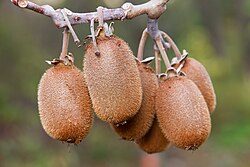Kiwifruit
Kiwifruit (Actinidia deliciosa) is a fruit. It has an oval shape. It is green on the inside with small black seeds that can be eaten. The kiwi has furry brown skin that is edible but is usually removed. The skin is relatively thin. The kiwi is native to South China.
The fruit was named in 1959 after the kiwi, a bird and the symbol of New Zealand. Before that, its English name was Chinese gooseberry.
The kiwifruit is healthy and contains many vitamins and minerals. Kiwis are rich in vitamin C, vitamin K, potassium, and fiber.[1] Kiwis have more vitamin C than an equivalent amount of orange.[2]
There are different types of kiwifruit. The main types are Hayward (the most common green kiwifruit), chico, Saanichton 12, and golden kiwifruit. Golden kiwifruit are sweeter than normal green kiwifruit. Golden kiwifruit was invented by grafting and cross-pollinating different types of kiwifruit.
Interesting facts about Kiwifruit
- Kiwifruit is a fruit that is known for its unique taste, which has been described as a combination of melon, citrus fruits, nectarines, and strawberries.
- The fruit originated in China, where it is known as yáng táo meaning “sunny peach” or mí hóu táo meaning “Macaque peach”.
- In New Zealand, kiwifruit used to be called Chinese gooseberries, but the name was changed to kiwifruit in 1959 after the national bird, the kiwi.
- Italy and New Zealand are the top producers of kiwifruit in the world.
- There are two types of kiwifruit: green and gold. The gold kiwifruit was first grown in the 1980s and has a golden yellow flesh with tiny black seeds. It is less hairy and has a hint of mango flavor.
- Kiwi can be used as a natural meat tenderizer.
- There are 400 varieties of kiwifruit in China.
- Kiwifruit is one of the most popular fruits today.
| This article is a stub. You can help WikiMD by registering to expand it. |
| Types of fruits | ||||||||
|---|---|---|---|---|---|---|---|---|
|
Transform your life with W8MD's budget GLP-1 injections from $125.
W8MD offers a medical weight loss program to lose weight in Philadelphia. Our physician-supervised medical weight loss provides:
- Most insurances accepted or discounted self-pay rates. We will obtain insurance prior authorizations if needed.
- Generic GLP1 weight loss injections from $125 for the starting dose.
- Also offer prescription weight loss medications including Phentermine, Qsymia, Diethylpropion, Contrave etc.
NYC weight loss doctor appointments
Start your NYC weight loss journey today at our NYC medical weight loss and Philadelphia medical weight loss clinics.
- Call 718-946-5500 to lose weight in NYC or for medical weight loss in Philadelphia 215-676-2334.
- Tags:NYC medical weight loss, Philadelphia lose weight Zepbound NYC, Budget GLP1 weight loss injections, Wegovy Philadelphia, Wegovy NYC, Philadelphia medical weight loss, Brookly weight loss and Wegovy NYC
|
WikiMD's Wellness Encyclopedia |
| Let Food Be Thy Medicine Medicine Thy Food - Hippocrates |
Medical Disclaimer: WikiMD is not a substitute for professional medical advice. The information on WikiMD is provided as an information resource only, may be incorrect, outdated or misleading, and is not to be used or relied on for any diagnostic or treatment purposes. Please consult your health care provider before making any healthcare decisions or for guidance about a specific medical condition. WikiMD expressly disclaims responsibility, and shall have no liability, for any damages, loss, injury, or liability whatsoever suffered as a result of your reliance on the information contained in this site. By visiting this site you agree to the foregoing terms and conditions, which may from time to time be changed or supplemented by WikiMD. If you do not agree to the foregoing terms and conditions, you should not enter or use this site. See full disclaimer.
Credits:Most images are courtesy of Wikimedia commons, and templates, categories Wikipedia, licensed under CC BY SA or similar.
Translate this page: - East Asian
中文,
日本,
한국어,
South Asian
हिन्दी,
தமிழ்,
తెలుగు,
Urdu,
ಕನ್ನಡ,
Southeast Asian
Indonesian,
Vietnamese,
Thai,
မြန်မာဘာသာ,
বাংলা
European
español,
Deutsch,
français,
Greek,
português do Brasil,
polski,
română,
русский,
Nederlands,
norsk,
svenska,
suomi,
Italian
Middle Eastern & African
عربى,
Turkish,
Persian,
Hebrew,
Afrikaans,
isiZulu,
Kiswahili,
Other
Bulgarian,
Hungarian,
Czech,
Swedish,
മലയാളം,
मराठी,
ਪੰਜਾਬੀ,
ગુજરાતી,
Portuguese,
Ukrainian
Contributors: Prab R. Tumpati, MD



